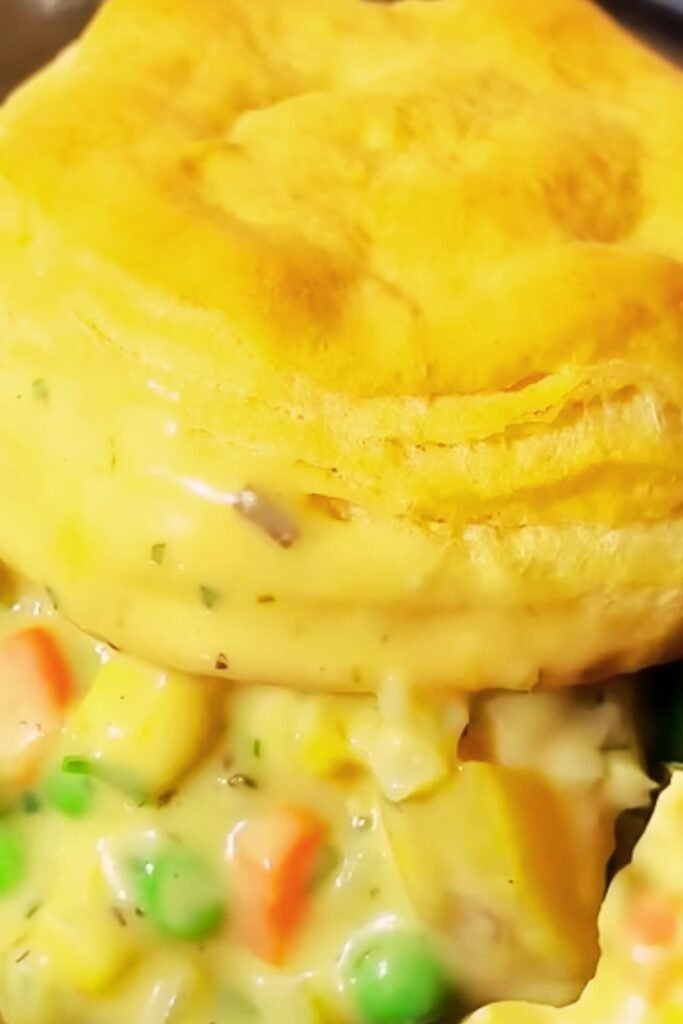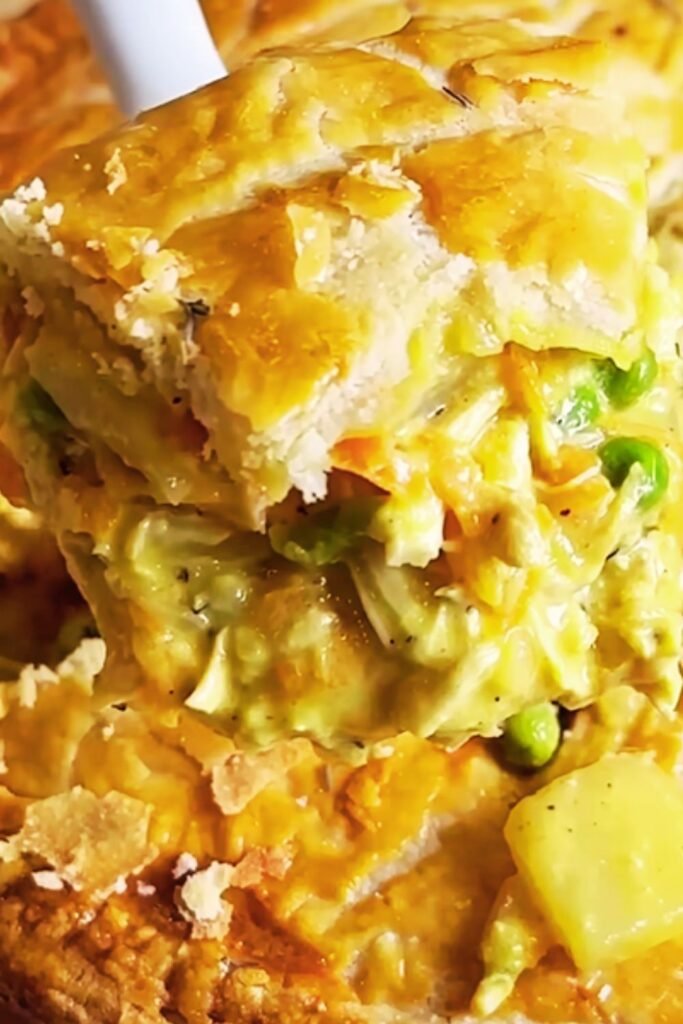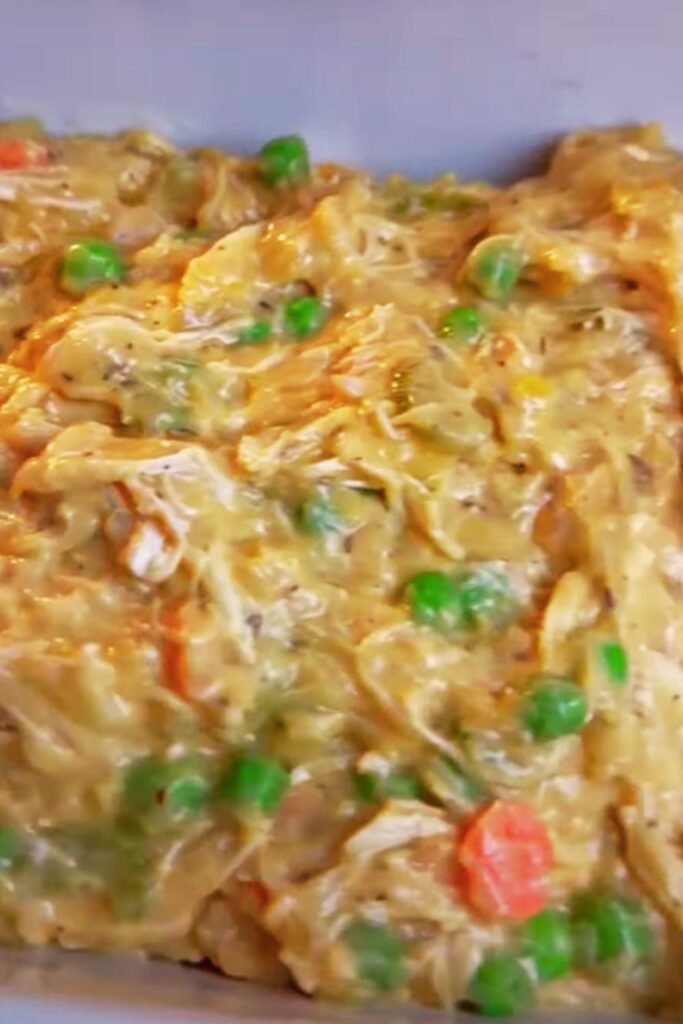When I first discovered that my trusty crockpot could transform simple ingredients into the most incredible chicken pot pie, I honestly thought it was too good to be true. After countless kitchen experiments and a few spectacular failures, I’ve perfected this recipe that delivers all the comfort of traditional pot pie without the hassle of pastry-making or oven-watching.
My journey with this dish began during one of those hectic weeks when I desperately needed something wholesome but simple. I threw together what I had in my pantry and fridge, crossed my fingers, and let my slow cooker work its magic. The result exceeded every expectation – tender chicken swimming in a rich, creamy sauce with perfectly cooked vegetables that maintained just the right bite.
What makes this recipe truly special isn’t just its incredible flavor, but how it fits seamlessly into busy lifestyles. I can prep everything in the morning, head out for my day, and return home to the most amazing aroma filling my kitchen. It’s become my go-to solution for everything from weeknight dinners to feeding unexpected guests.
Essential Terms and Definitions
Slow Cooking : A cooking method that uses low, steady heat over extended periods, allowing flavors to develop and merge while keeping proteins tender and juicy.
Roux-Free Thickening : My technique for creating creamy sauces without the traditional flour-butter mixture, using cream soups and natural starches from vegetables instead.
Layering Strategy : The specific order of adding ingredients to ensure even cooking and optimal flavor distribution in the crockpot.
Carry-Over Cooking : The continued cooking that happens after removing food from heat, which I account for in my timing recommendations.
Why This Method Works So Well
The slow cooker creates an ideal environment for chicken pot pie because it maintains consistent, gentle heat that breaks down tough fibers in the chicken while preserving the integrity of vegetables. Unlike stovetop methods that require constant attention, this approach allows ingredients to meld naturally without risk of scorching or uneven cooking.
I’ve discovered that the enclosed environment of the crockpot creates a perfect steam chamber. This steam keeps the chicken incredibly moist while allowing the flavors to concentrate and intensify. The result is a dish that tastes like it’s been simmering for hours – because it literally has been!
Complete Ingredient Breakdown
Protein Selection and Preparation
Chicken Choice: I exclusively use bone-in, skin-on chicken thighs for this recipe. While boneless pieces work, bone-in thighs provide superior flavor and stay more tender during extended cooking. The bones release gelatin, which naturally thickens the sauce and adds richness that you simply can’t achieve with boneless cuts.
Quantity Guidelines: For my standard 6-quart crockpot, I use approximately 2.5 pounds of chicken thighs. This typically means 6-8 pieces, depending on size. I remove the skin before cooking to prevent excess grease, but keep the bones for maximum flavor development.
Vegetable Foundation
The Holy Trinity: My vegetable base consists of diced onions, carrots, and celery – each cut into uniform ½-inch pieces. This size ensures they cook evenly and maintain some texture without becoming mushy.
Potato Considerations: I prefer Yukon Gold potatoes for their creamy texture and ability to hold their shape. I cut them into ¾-inch cubes, which provides substantial bites without overwhelming the dish.
Frozen Peas: These go in during the final hour only. Adding them earlier results in olive-green mush that nobody wants to eat.
Sauce Components
Cream Base: I use two cans of cream of chicken soup as my foundation. This provides both flavor and initial thickening power. I always choose high-quality brands because the difference in taste is noticeable.
Liquid Elements: Chicken broth adds depth without thinning the sauce too much. I use low-sodium varieties to control salt levels better.
Dairy Finish: Heavy cream goes in during the last 30 minutes to prevent curdling. This creates the luxurious, velvety texture that makes this dish special.

Step-by-Step Cooking Process
Initial Preparation (15 minutes)
I start by seasoning the chicken thighs generously with salt and pepper. This initial seasoning is crucial because it penetrates the meat during cooking and builds flavor from the inside out.
Next, I prepare all vegetables while the chicken comes to room temperature. Room temperature chicken cooks more evenly than cold chicken straight from the refrigerator.
Layering Strategy
Bottom Layer: Seasoned chicken thighs go directly on the bottom of the crockpot. Direct contact with the heat source ensures proper cooking.
Vegetable Layer: I arrange the diced onions, carrots, and celery around and over the chicken. These vegetables release moisture during cooking, creating steam that keeps everything moist.
Potato Addition: Cubed potatoes get distributed evenly over the vegetables. Their starches will help thicken the sauce naturally.
Sauce Creation: In a separate bowl, I whisk together cream of chicken soup, chicken broth, and all seasonings until smooth. This mixture gets poured over everything in the crockpot.
Cooking Timeline and Checkpoints
Hours 1-2: The initial heating phase. I resist the urge to lift the lid, which would release precious steam and extend cooking time.
Hour 3: First checkpoint. I check if the chicken is tender enough to shred easily with a fork. If not, I continue cooking.
Hour 4: Chicken removal and shredding. I carefully remove the bones and shred the meat into bite-sized pieces.
Final Hour: I return the shredded chicken to the pot, add frozen peas and heavy cream, and let everything finish cooking together.
Detailed Nutritional Analysis
| Nutrient | Per Serving (1.5 cups) | % Daily Value | Health Benefits |
|---|---|---|---|
| Calories | 342 | 17% | Sustained energy |
| Protein | 28g | 56% | Muscle maintenance |
| Total Fat | 18g | 23% | Hormone production |
| Saturated Fat | 8g | 40% | Fat-soluble vitamins |
| Cholesterol | 98mg | 33% | Cell membrane health |
| Sodium | 920mg | 40% | Electrolyte balance |
| Total Carbs | 26g | 9% | Brain fuel |
| Dietary Fiber | 4g | 14% | Digestive health |
| Sugars | 6g | – | Natural vegetable sugars |
| Vitamin A | 3,200 IU | 64% | Eye health |
| Vitamin C | 18mg | 20% | Immune support |
| Calcium | 120mg | 12% | Bone health |
| Iron | 2.8mg | 16% | Oxygen transport |
| Potassium | 680mg | 19% | Heart health |
This recipe provides exceptional nutritional value, particularly in protein content and essential vitamins. The combination of lean protein and nutrient-dense vegetables creates a well-balanced meal that supports overall health while satisfying comfort food cravings.
Advanced Cooking Techniques
Temperature Control Mastery
I’ve learned that slow cooker temperatures can vary significantly between models and even between different areas of the same cooker. I always use the low setting for this recipe because the gentle heat prevents the dairy from curdling and keeps the chicken tender.
Timing Adjustments
Smaller Crockpots (4-quart): Reduce cooking time by 30-45 minutes and check for doneness earlier.
Larger Crockpots (8-quart): May require additional 30-60 minutes due to increased thermal mass.
Altitude Considerations: At higher altitudes, liquids evaporate faster, so I add an extra ½ cup of broth and monitor moisture levels.
Texture Optimization
Preventing Mushy Vegetables: I cut harder vegetables slightly larger and add delicate ones later in the cooking process.
Achieving Perfect Thickness: If the sauce is too thin, I create a slurry with cornstarch and cold water, stirring it in during the last 30 minutes.

Creative Variations and Adaptations
Seasonal Modifications
Spring Fresh: I incorporate fresh asparagus spears and baby carrots during the final hour. Fresh herbs like chives and parsley added at the end brighten the entire dish.
Summer Garden: Sweet corn kernels and diced zucchini work beautifully. I add these during the last 45 minutes to maintain their texture and vibrant colors.
Autumn Harvest: Butternut squash and sweet potatoes create a heartier version. I cube these root vegetables and add them with the regular potatoes.
Winter Comfort: Parsnips and turnips add earthy depth. These hardy vegetables can handle the full cooking time and contribute unique flavors.
Dietary Accommodations
Gluten-Free Version: I substitute gluten-free cream of chicken soup and ensure all seasonings are certified gluten-free. The natural thickening from potatoes means no flour is needed.
Dairy-Free Alternative: Full-fat coconut milk replaces heavy cream beautifully. I use dairy-free cream of mushroom soup and add nutritional yeast for umami depth.
Lower-Carb Option: I replace potatoes with cauliflower florets and add them during the final hour. The result is lighter but equally satisfying.
Protein Boost: Sometimes I add white beans or chickpeas for extra protein and fiber. These go in during the last hour to prevent breaking apart.
Serving Suggestions and Presentation
Classic Accompaniments
Biscuit Toppers: I serve this over warm, fluffy biscuits that soak up the creamy sauce. Drop biscuits work perfectly, or I’ll warm store-bought ones in the oven.
Bread Bowls: Hollowed-out sourdough boules create an impressive presentation for special occasions. The bread absorbs the sauce and becomes part of the meal.
Rice Base: Sometimes I serve this over fluffy white rice or wild rice for a different texture experience.
Fresh Additions
Green Salad: A simple mixed greens salad with vinaigrette cuts through the richness and adds nutritional balance.
Roasted Vegetables: Roasted Brussels sprouts or green beans provide color contrast and additional nutrients.
Pickled Elements: A small portion of pickled vegetables adds acidity that brightens the entire meal.
Storage and Meal Planning
Refrigerator Storage Guidelines
| Storage Method | Duration | Best Practices |
|---|---|---|
| Airtight Containers | 4-5 days | Cool completely before storing |
| Freezer Bags | 3 months | Remove excess air, label with date |
| Individual Portions | 4 days | Perfect for meal prep |
| Family Portions | 5 days | Reheat only what you’ll consume |
Freezing Considerations
This recipe freezes exceptionally well, but I’ve learned a few tricks for best results. I slightly undercook the vegetables initially, knowing they’ll finish cooking during reheating. I also freeze the mixture before adding heavy cream, incorporating it fresh when reheating.
Reheating Methods
Stovetop: My preferred method. I reheat gently over medium-low heat, stirring frequently and adding a splash of broth if needed.
Microwave: Works for individual portions. I use 50% power and stir every minute to ensure even heating.
Oven: For larger portions, I reheat covered at 350°F until heated through, stirring once halfway through.

Cost Analysis and Budget Optimization
| Ingredient Category | Cost Range | Money-Saving Tips |
|---|---|---|
| Chicken Thighs | $4-8 | Buy family packs, freeze portions |
| Vegetables | $3-5 | Use frozen when fresh is expensive |
| Dairy Products | $3-4 | Buy in bulk, check expiration dates |
| Pantry Staples | $2-3 | Stock up during sales |
| Total per Recipe | $12-20 | Serves 6-8 people |
| Cost per Serving | $1.50-2.50 | Exceptional value |
This recipe delivers restaurant-quality comfort food at a fraction of the cost of dining out. I often make double batches when ingredients are on sale, freezing half for future meals.
Troubleshooting Common Issues
Texture Problems
Watery Sauce: Usually caused by too much liquid or not enough thickening. I fix this by making a cornstarch slurry and cooking uncovered for the last 30 minutes.
Dry Chicken: Overcooking is the culprit. I prevent this by checking doneness early and using a meat thermometer when in doubt.
Mushy Vegetables: Adding vegetables too early or cooking too long causes this. I’ve learned to stagger additions based on cooking times.
Flavor Issues
Bland Taste: Under-seasoning is common in slow cooking. I always taste and adjust seasonings during the last hour.
Too Salty: Over-salted canned soups can cause this. I use low-sodium versions and add salt gradually.
Lack of Depth: This happens when I skip the browning step. While not essential, browning the chicken first adds significant flavor.
Frequently Asked Questions
Q: Can I use a different cut of chicken for this recipe? A: Absolutely! While I prefer thighs for their flavor and tenderness, chicken breasts work too. I reduce the cooking time by about 30 minutes and check for doneness earlier to prevent overcooking.
Q: What’s the best way to prevent the dairy from curdling? A: Temperature control is key. I always add heavy cream during the last 30 minutes of cooking and never let the mixture come to a full boil. If it does start to curdle, I whisk in a bit of cold cream to smooth it out.
Q: Can I make this recipe ahead of time? A: Yes! I often prep all ingredients the night before, store them in the refrigerator, and start the crockpot in the morning. You can also make the entire dish ahead and reheat it – the flavors actually improve overnight.
Q: How do I know when the chicken is properly cooked? A: The chicken is done when it easily shreds with a fork and reaches an internal temperature of 165°F. It should fall apart without resistance when you try to break it up.
Q: What if I don’t have cream of chicken soup? A: I sometimes make my own by whisking together chicken broth, heavy cream, and a flour slurry. Cream of mushroom soup also works well and adds a different but delicious flavor profile.
Q: Can I add dumplings to this recipe? A: Definitely! I add drop biscuit dough during the last hour of cooking. The dumplings steam perfectly in the crockpot and make it a complete one-pot meal.
Q: Why does my sauce separate sometimes? A: Sauce separation usually happens when the temperature gets too high or when dairy is added too early. I keep the heat on low and add cream products only in the final stages of cooking.
Q: How can I make this recipe spicier? A: I add cayenne pepper, hot sauce, or diced jalapeños to taste. Start with small amounts – you can always add more, but you can’t take it out once it’s in there.
Q: What’s the best crockpot size for this recipe? A: I use a 6-quart crockpot for this recipe. A 4-quart works but will be very full, while an 8-quart might require longer cooking times due to the increased space.
Q: Can I use frozen chicken? A: I don’t recommend using frozen chicken in slow cookers due to food safety concerns. The meat needs to reach safe temperatures quickly, which doesn’t happen when starting from frozen. I always thaw chicken completely before cooking.
After years of perfecting this recipe, I can confidently say it’s become one of my most requested dishes. Friends and family constantly ask for the recipe, and I love how it brings people together around the dinner table. The beauty of this crockpot chicken pot pie lies not just in its incredible flavor, but in its ability to transform simple ingredients into something truly special with minimal effort.
Whether you’re cooking for a busy weeknight dinner or preparing for weekend guests, this recipe delivers consistent, satisfying results every time. I encourage you to make it your own by experimenting with different vegetables, seasonings, and serving styles. The foundation is incredibly forgiving, making it perfect for both novice cooks and experienced home chefs looking for a reliable comfort food solution.
Give this recipe a try, and I’m confident it will earn a permanent place in your meal rotation, just as it has in mine. There’s something magical about coming home to the aroma of this dish filling your kitchen – it’s comfort food at its absolute finest.